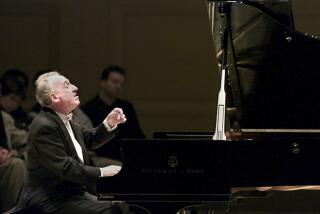A book in 88 keys
- Share via
IN “Piano,” James Barron follows the creation of a single Steinway concert grand piano, from the first bending of the rim to the last speck of dust wiped from its shiny black finish. (The process takes slightly longer than it does to make a human being, though for most of that time the piano is just hanging around, drying out, settling.) Along the way, he visits with each worker in the process, rustling a few facts about their background and a few comments on what they do. Between stops, he tells the history of the Steinway enterprise, from German home project -- Heinrich Engelhard Steinweg (the name was later Anglicized to Steinway) made his first piano in his kitchen, according to family lore -- to an American institution.
A piano is not just any instrument and not just an instrument -- it is also a machine and a piece of furniture, and these considerations go into making one. It does its deceptively simple business via a complex array of levers and pivots and hammers, strings and resonators, perfected in increments and occasional leaps over the last three centuries. It takes a small army to build one and teams of ancillary professionals to move it around and keep it in good tune and trim.
And a Steinway is not just any piano. It has a sonic character and physical responsiveness all its own -- as, to be sure, do Baldwins and Yamahas and Bosendorfers -- the product of more than 150 years of tinkering, not only with its myriad, often patented, components but also with the way in which they are put together. Just as important, the name has a romantic historical resonance; it personifies classical music to those outside classical music. As a piano made in America -- in Queens, in New York City -- by a company that makes only pianos, and largely by hand, it is also something of an anachronism. (There is a Hamburg, Germany, branch as well; its pianos have a different look and character.)
Barron’s is a beguiling and seemingly simple conceit, but his thoroughness comes at a price. This isn’t a bad book, but it can be a frustrating one. It began as a series of articles in the New York Times, where the author is a staff writer, and was probably better suited to that rhythm -- occasional pieces spread over the course of the piano’s gestation -- than to a single reading. And though Barron offers fistfuls of facts about everyone he meets, he doesn’t stick around with any of them long enough to make them real. Sometimes the author does manage to put you in the room, however, and evoke the noise and dust of an old factory where the “floors are so worn that everyone has memorized where the dips are” -- and to find drama in a process that, for the most part, is not dramatic.
As to the piano itself -- known as K0862 during its production and CD-60 (for “concert division”) when it begins its professional life -- it’s such a complicated mass of parts, big and small and largely unfamiliar, that it’s not always easy to keep a clear picture of what’s going on. And it’s a challenge to make all the bending, drilling, screwing and sanding compelling to someone not already particularly compelled by bending, drilling, screwing and sanding.
Not surprisingly, “Piano” is most exciting at the beginning, when all is possibility, and toward the end, when a musical instrument is born. (CD-60 eventually takes up residence in a recital hall at the Metropolitan Museum of Art.) Despite the fact that each concert grand is made to the same precise specifications, exactly how it will sound is impossible to predict. Each has its own personality -- “colorations of sound, nuances of strength or delicacy” -- which unfolds over time as the instrument ripens with playing. The construction and revelation of that personality is the backbone of Barron’s narrative.
The historical passages are largely well told, as the Steinways move from the world of immigrant artisans to the very center of New York and its political and cultural life. Barron admits that he’s not a historian, and relies largely on secondary sources for these sections, although he was able to talk to Henry Z. Steinway, the last Steinway to run the place. (The company has changed hands twice since Steinway oversaw its sale to CBS in 1972.) It’s not a deep history; there are passing references to questions that beg for elaboration, especially given how much the book has to do with labor -- about worker safety, or the fact that the factory used to run on a piecework system. But Barron moves on, following the piano.
Even as he doggedly anthropomorphizes his subject (“Being a New Yorker, CD-60 spends most of the summer of 2005 in the Hamptons”), he is never able to bring his protagonist alive. As a conscientious reporter, he has taken himself out of the picture and, although this may be good newspaper style, it doesn’t work here. When he wants a poetic description, he quotes another writer or a musician. Yet we’re told in a biographical note that Barron is “an accomplished amateur pianist,” and presumably he has laid his hands upon his title character -- how could he resist? His own reaction would have been welcome, being firsthand and felt.
But there’s much of interest here, nevertheless, in this sometimes surprising tale of the humble beginnings of a musical aristocrat. *
More to Read
The biggest entertainment stories
Get our big stories about Hollywood, film, television, music, arts, culture and more right in your inbox as soon as they publish.
You may occasionally receive promotional content from the Los Angeles Times.











